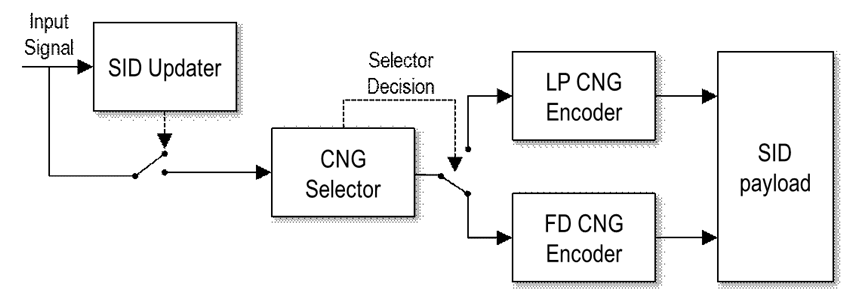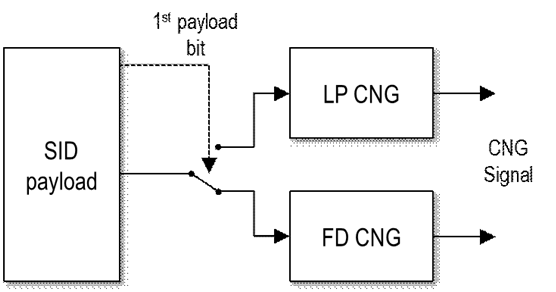TS 26.449
Codec for Enhanced Voice Services (EVS) –
Comfort Noise Generation (CNG) Aspects
V17.0.0 (PDF)
2022/03 10 p.
V16.0.0
2019/03 10 p.
V15.1.0
2019/03 10 p.
V14.1.0
2019/03 10 p.
V13.1.0
2019/03 10 p.
V12.1.0
2019/03 10 p.
- Rapporteur:
- Mr. Schnell, Markus
Fraunhofer IIS
Content for TS 26.449 Word version: 17.0.0
1 Scope p. 5
The present document gives an overview for the requirements of the background acoustic noise evaluation, noise parameter encoding/decoding and comfort noise generation for the Enhanced Voice Services (EVS) speech codec during Discontinuous Transmission (DTX) operation.
2 References p. 5
The following documents contain provisions which, through reference in this text, constitute provisions of the present document.
- References are either specific (identified by date of publication, edition number, version number, etc.) or non-specific.
- For a specific reference, subsequent revisions do not apply.
- For a non-specific reference, the latest version applies. In the case of a reference to a 3GPP document (including a GSM document), a non-specific reference implicitly refers to the latest version of that document in the same Release as the present document.
[1]
TR 21.905: "Vocabulary for 3GPP Specifications".
[2]
TS 26.445: "Codec for Enhanced Voice Services (EVS); Codec Detailed Algorithmic Description".
[3]
TS 26.442: "Codec for Enhanced Voice Services (EVS); EVS Codec ANSI C code (fixed-point)".
[4]
TS 26.443: "Codec for Enhanced Voice Services (EVS); EVS Codec ANSI C code (floating-point)".
[5]
TS 26.452: "Codec for Enhanced Voice Services (EVS); ANSI C code; Alternative fixed-point using updated basic operators".
3 Abbreviations p. 5
For the purposes of the present document, the abbreviations given in TR 21.905 and the following apply. An abbreviation defined in the present document takes precedence over the definition of the same abbreviation, if any, in TR 21.905.
CNG
Comfort Noise Generation
EVS
Enhanced Voice Services
FD-CNG
Frequency Domain based CNG
LP-CNG
Linear Prediction based CNG
SID
Silence Insertion Descriptor
4 General p. 5
The present document gives an overview for the requirements of the background acoustic noise evaluation, noise parameter encoding/decoding and comfort noise generation for the Enhanced Voice Services (EVS) speech codec during Discontinuous Transmission (DTX) operation.
The procedure of the present document is mandatory for implementation in all network entities and UEs supporting the EVS codec.
In the case of discrepancy between the EVS comfort noise aspects described in the present document and its ANSI-C code specification contained in TS 26.442, the procedure defined by TS 26.442 prevails. In the case of discrepancy between the procedure described in the present document and its ANSI-C code specification contained in TS 26.443, the procedure defined by TS 26.443 prevails. In the case of discrepancy between the procedure described in the present document and its ANSI-C code specification contained in TS 26.452, the procedure defined by TS 26.452 prevails.
A basic problem when using DTX is that the background acoustic noise, which is transmitted together with the speech, would disappear when the transmission is cut, resulting in discontinuities of the background noise. Since the DTX switching can take place rapidly, it has been found that this effect can be very annoying for the listener - especially in a car environment with high background noise levels. In bad cases, the speech may be hardly intelligible.
The present document specifies the way to overcome this problem by generating on the receive (RX) side synthetic noise similar to the transmit (TX) side background noise. The comfort noise parameters are estimated on the TX side and transmitted to the RX side at a regular rate when speech is not present. This allows the comfort noise to adapt to the changes of the noise on the TX side.
The Enhanced Voice Services (EVS) speech codec supports two Comfort Noise Generation (CNG) schemes, a linear prediction based CNG (LP-CNG) as well as a frequency domain based scheme (FD-CNG). The selection of the one of the two schemes is performed within the transmit side functions on an input signal bases. The parameters for generating the comfort noise are packed as a Silence Insertion Descriptor (SID) payload.
By default in the command line the transmission rate of CNG update is fixed to 8 frames. However, the update rate of the SID payload can be configured by a command line parameter to a fixed number or to a mode where the update rate is adaptively modified according to the background noise. The fixed rate mode is limited to updates between 1 and 100 frames while in the adaptive rate mode the updates are limited to 8 and 50 depending on the noise behaviour.
As the functions of the CNG processing are highly integrated into the speech codec and make use of other coding parameters, The present document only provides an overview of the functions. The relevant references to the algorithmic descriptions are provided in the following.
5 Functions on the transmit (TX) side p. 6
5.1 EVS primary CNG operation p. 6
The CNG operation on the transmit side is described in Figure 1. In DTX operation, the SID updater decides if any SID update is required. If the SID payload should be updated, the CNG Selector enables either the LP or the FD CNG encoder depending on the signal characteristic of the background noise. The selected CNG encoder calculates the noise generation parameter and creates the related SID payload.

5.2 EVS AMR-WB IO CNG operation p. 7
The update rate is basically fixed to an update every 8th frame. However, when switching into DTX mode, the first and the third frame after active speech are coded by a SID frame.
The CNG in the EVS AMR-WB interoperable modes is based the LP-CNG coding scheme only. The complete CNG TX description of the EVS AMR-WB IO mode can be found in TS 26.445, clause 5.7.12.
6 Functions on the receive (RX) side p. 7
6.1 EVS primary CNG operation p. 7
The CNG operation on the receiver side is depicted in Figure 2. The first bit of the SID payload determines the CNG module. The remaining bits contain the information of the noise generator parameters to render the signal.

The RX CNG operation is described in clause 6.7 of TS 26.445. The synthesis of the LP-CNG is described in subclause 6.7.2 of TS 26.445 and the synthesis of FD-CNG is described in clause 6.7.3 in TS 26.445.
6.2 EVS AMR-WB IO CNG operation p. 7
The CNG in the EVS AMR-WB interoperable modes use only the LP-CNG decoding scheme for rendering the AMR-WB compatible CN parameters. The complete CNG RX description of the EVS AMR-WB IO mode can be found in TS 26.445, clause 6.8.4.
7 Computational details and bit allocation p. 7
A computational description of comfort noise encoding and generation in form of an ANSI-C source code is given in TS 26.442 and TS 26.452 for the two fixed-point implementations, using different sets of basic operators, and in TS 26.443 for the floating-point implementation.
For the EVS primary modes, the SID payload consists of 48 bits. The first bit of the payload determines the CNG scheme, where 0 stands for the LP-CNG and 1 for the FD-CNG.
For the EVS AMR-WB IO modes, the SID payload consists of 35 bits.